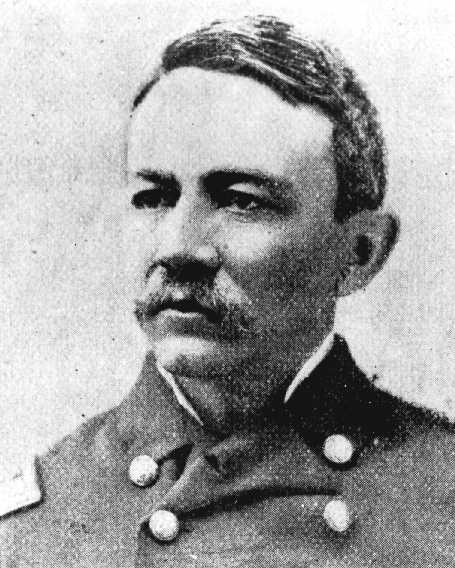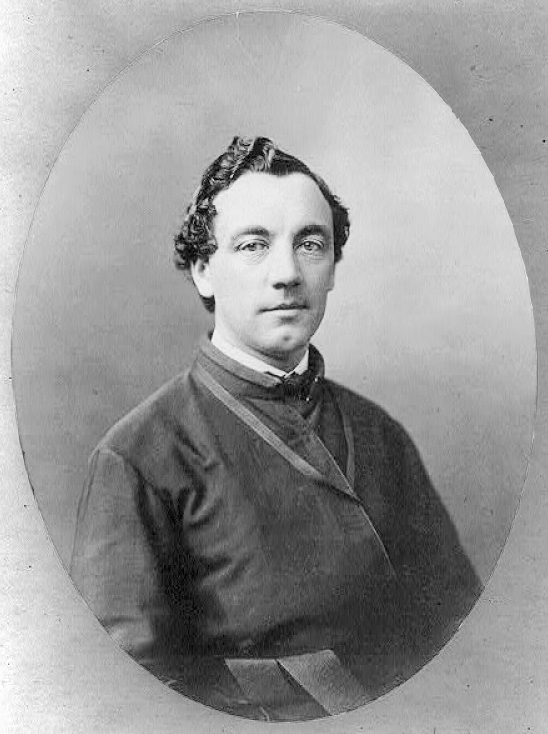
Bishop James Healy, first bishop with African ancestry
The level of racism that existed among white Americans can be mind-boggling to the modern mind. Even whites who are sensitive to the racial situation fail to grasp just how oppressed anybody with Black African ancestry could be treated in this country. All three world powers – England, France and Spain – of our colonial era enslaved Africans who were sold to traders on the western coast of Africa. These unfortunates were packed into the horrible slave ships and sent across the Atlantic, in a bewildering mixture of tribes and nations, to the West Indies or North America. In the English colonies, the Africans eventually became property, listed as assets along with horses and cows. The infamous Three Fifths Compromise counted slaves as being equal to 3/5 of a white person, and it was in our Constitution! In the Dred Scott Decision, our Supreme Court ruled that anyone who had a slave ancestor was denied American citizenship, and therefore protection under the law. This was fiercely opposed by Republicans, and led directly to the Civil War. The Catholic Church’s institutions owned slaves, as did many Catholics. Catholic owners were obliged to provide religious instruction and services for their slaves, although the slaves – and free people of color – had to sit behind whites in church or in the choir loft, and could not receive Holy Communion with white parishioners.

Slavery in the American South had been declining at the time of the Revolution, with a class of free persons of color arising, until the invention of the cotton gin in 1793 resulted in a vast expansion of cotton plantations, and the “peculiar institution” spread. The spread of cotton planting went hand in hand with the destruction of family life, as not even spouses were kept together, let alone children. Our slavery system was much different from the one known to Saint Paul, and much crueler. People were even subjected to breeding, whereby marital relationships were ignored in favor of producing the best candidates for labor, and rape by white owners of black women was common.
A Catholic Irishman, Michael Healy, won 1,300 acres in an 1823 land lottery in Georgia. In 1829, he fell in love with Mary Eliza Smith (or Clark), a mulatto woman who he had purchased from another planter. She was half-white, but could not be freed, even by him, and they could not legally marry. The Georgia Legislature had to approve each act of freeing a slave by an owner, and few people were granted this “privilege”. Mary Eliza and Michael had nine children who survived to adulthood, and who by law were considered slaves because of their “tainted” blood. Those tainted children would become the first African Americans to be ordained priests (James, Sherwood, Patrick) a bishop (James), to hold a university doctorate (Patrick, at Louvain) president of a university (Patrick), diocesan chancellor (James), hold a command military posting over white soldiers and officers (Michael), serve as a Mother Superior over white Sisters (Eliza). They were a remarkable family – just think of all the other unknown talents lost to our Church and our country due to racial prejudice. In the North, their three-quarters white ancestry and light coloring enabled most of them to pass as white Irish Catholics, although their African ancestry caused problems for those who pursued religious vocations. Had they stayed in the South, none of their achievements would have taken place.
A chance encounter with Bishop John Fitzpatrick of Boston resulted in four sons going to Holy Cross College, and the Notre Dame Sisters of Montreal accepting the three daughters. Here the first three sons finally became Catholics, along with the sons of the famous convert Orestes Brownson, in 1844. James and Sherwood went to Canada and then Paris to study because no United States seminary would take in a “colored” student, no matter how white they looked. The parents decided that their children must all live in the North to be safe and thus have careers in the Church or business, and were going to sell the plantation and go north and be legally married, bringing along the three remaining children. In 1850 both Mary Eliza and Michael died before they could fulfill their dream; since planters’ children could be sold, regardless of their white ancestry, the older children intervened to rescue their siblings.
That the parents did not have a state-recognized marriage was an impediment to priesthood and vows in those days, and Bishop Fitzpatrick had to intervene for all the Healys who served the Church. In 1854, James was ordained a priest after finishing his studies in Paris – the first American Catholic priest with African ancestry. Patrick entered the Jesuits – who owned slaves – in Maryland where he took his vows, and Sherwood also studied in Montreal and then Paris. Hugh had graduated from Holy Cross and gone into business, but died at the age of twenty-one due to illness.Father Sherwood was an expert in Gregorian chant, rector of a seminary, at Troy in New York state, and because of his talents was nominated to become the head of the North American College in Rome. His appointment was forbidden by the Americans because “he has African blood and it shows in his exterior” and there was fear that certain seminarians would refuse to obey him as a result. He died, not knowing this fact, at the age of thirty-nine. Josephine died early also, in the Canadian Religious of Saint Joseph the Hospitaller: she could not enter an Order in the United States due to her ancestry.

Captain Michael Augustine Healy
Daughter Eliza entered the Sisters of Notre Dame in 1874 at Montreal – no United States community would receive her. As Sister Mary Magdalene she flourished, teaching in Quebec. Her greatest challenge was in Vermont, where she took over a school in serious financial trouble. Even the diocese would not back her. She used her talents to not only pay off the debts, but make the school and convent one of the best in the Order, and she was the first African American Mother Superior. In 1918 she had to resign as superior due to new canon laws which limited the time a superior could serve in one post, and she took over a school on Staten Island, where she served as Superior once again until her death. Daughter Martha also entered the convent, but eventually left to join her brothers in Boston and married an Irishman and had children. Son Eugene is listed as never having really been settled in life. All of them passed as white in the North – they were accepted as being Irish Catholics, and did not mingle with African Catholic parishes or laity. Michael rose in the ranks of the US Cutter Service to become a captain, the first African American to hold a command posting in our military, in Alaska. He married a white woman and raised a family. Healy descendants still live in the Lowell area of Massachusetts.
Father Patrick worked himself to exhaustion, especially as the “second founder of Georgetown”. He became the first person of partial African ancestry to obtain a Catholic doctorate, but he had to do so at Louvain, Belgium, because his African blood was an issue as America headed to the Civil War and passions rose over racial issues. Father Patrick returned as a professor and became the first African American head of a Catholic university at Georgetown in 1874. He worked hard to expand the university, and did a very good job at it, but wealthy donors were known to back out when they realized his partial African ancestry: that he was a good priest, teacher and administrator would by rejected by these worthy souls because of his Black ancestry. His piety and work did not save his legacy entirely – when his African ancestry was publicly acknowledged by the Society of Jesus and the university in the 1950s, a white Georgetown University student vandalized the portrait of him.

Father Patrick Healy, SJ
Bishop James Augustine Healy was the first-born child, and he continued the “first” status all his life. He had a vigorous ministry in Boston, becoming the first diocesan chancellor, and helping his bishop as he had aged and become ill. He defended the rights of Catholic children in public orphanages where they were deprived of the Sacraments, and convinced the old-line Puritan establishment to finally yield on this in 1875. His preaching was legendary. At the State House he spoke at public hearings to fight proposed tax laws which would have devastated the Catholic churches, schools, and charitable institutions. In 1875, Pope Pius IX named him Bishop of Portland, Maine, as the first bishop in the country with African ancestry, which embraced both Maine and New Hampshire. Being part Irish and fluent in French, he could serve the two main Catholic populations in those states well.

Portrait of Bishop James Healy
As bishop, he would establish 60 parishes with construction of new churches, 18 schools, new convents and charitable institutions for children and the poor. He was popular with Portland’s children, letting them hook their sleds to the back of his horse-drawn sleigh, letting those without sleds ride with him, and helping the orphans. He paid overdue taxes and doctor bills for the poor, and unlike some bishops, he continued to go on sick calls and hear Confessions. Hearing Confessions led to some interesting moments. We know from stories passed down by those who were the confessing party, that he heard people confess that they had sinned by calling their bishop derogatory terms for Negro. In one case, a girl confessed that she had said “that the bishop was black as the devil.” To her chagrin, he revealed who he was and said that in the future perhaps she should say “black as coal.”
Bishop James and Father Patrick both had health issues, and Bishop James had to leave Maine for warmer climates during the hard winters. The brothers traveled down to New Orleans and other southern locales, but they never once went back to their home state of Georgia. They never lived to see the racial laws revoked in our country that made their parents criminals. The Catholic Church would not appoint another African American Bishop for nearly 100 years, Bishop Harold Perry, SVD, of Washington DC in 1965.
Next Installment: First African American Catholic Priest
Leave a comment